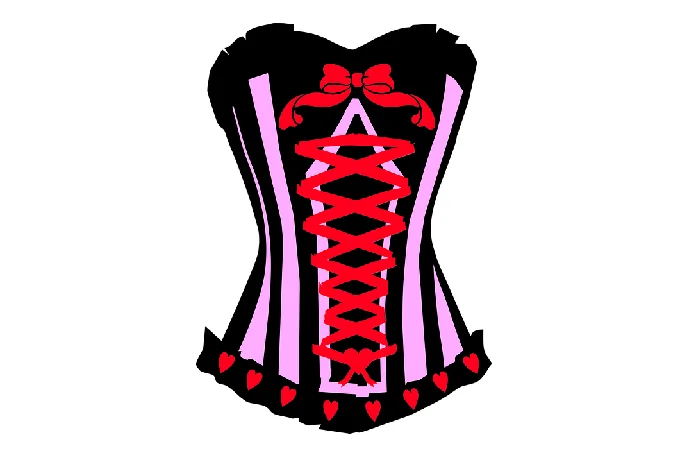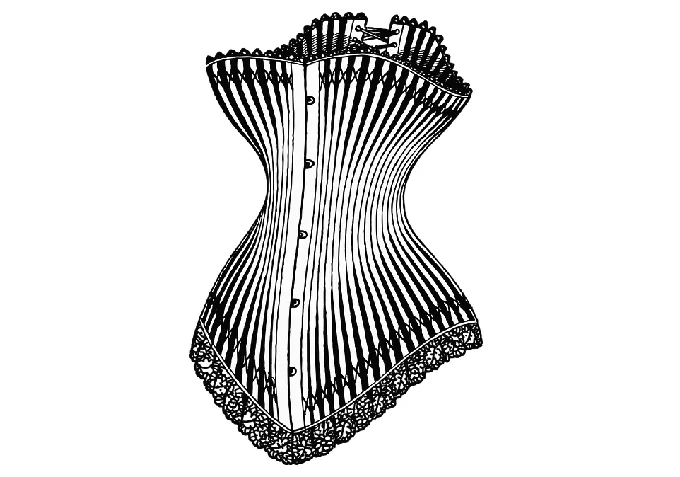History of the corset and why women agreed to wear corsets for centuries?

The irreconcilable discussion of supporters and opponents of corsets, which unfolded at the end of the 19th century and continued for decades, was quite unexpectedly ended by the outbreak of the First World War, and the reasons for this were quite material.
An attempt to revive this detail of the women’s wardrobe took place in the thirties, but then the events of 1939 changed everything. However, the corset, which kept the female, and sometimes the male body in a rigid framework, has not gone into the past for so many centuries.
Corsets as a way to enhance the look of a dress
Something similar to a corset was worn four thousand years ago – the corresponding images were found on the ruins of Cretan Knossos. But when and in what country they began to wear corsets in modern times – it remains unclear.
It is quite possible that the idea to improve the silhouette of the dress in this way was brought to France by Catherine de Medici in the 16th century. Other female ruling persons also claim the role of legislators of corset fashion. One way or another, corsets began to be worn by the most senior representatives of the European aristocracy.
At first, they did not try to tighten the waist with the help of a corset, its main function was to achieve a smooth surface of the corsage – that is, that part of the dress that covered the bust. Therefore, the first corsets were constructions of several pieces of fabric glued together.

During the reign of Queen Elizabeth I of England – and at her suggestion – they began to wear whalebone corsets, which made it possible to fix and hold the outlines of the body. The first generations of corsets provided the smoothness of dress fabrics and served as the basis for jewelry, while helping women keep their backs straight and their shoulders back.
Aristocrats in those days did not suffer from the inconvenience caused by the desire to become several sizes slimmer due to the wearing of a corset – and the tasks before it for a long time were different. For example, already in the 17th century, when it became fashionable to wear a large amount of jewelry and generally make your dress as luxurious as possible, corsets helped to hold heavy pieces of jewelry. To get the latest stories, install our app here.
Corsets as a tool for perfect posture and harmony
Corsets of the 18th century were designed to maintain a beautiful posture and helped to create a contrast between a smooth corsage and a puffy, pleated skirt. But with the beginning of the 19th century, fashion for some time denied corsets the right to a female body: they wore clothes with a high waist, in the Empire style: this was how Napoleon’s wife Josephine Beauharnais appeared before the artist.

However, not all aristocrats in those days were able to abandon a clear silhouette and a chiseled waist, and soon the corset returned – to become a real dictator for women.
Is it only for women? Oddly enough, no – and men were inclined to resort to this method to smooth out figure flaws. Of course, men’s corsets were much less common, and it was permissible to wear them without sidelong glances for a very short period of time. But when tight-fitting trousers and jackets came into fashion at the beginning of the 19th century, many fashionistas resorted to the help of a corset to smooth out the silhouette and achieve greater harmony. However, after a couple of decades, this trend has already become a thing of the past, and instead of corsets, they began to wear narrow vests.
Starting from the 1830s, the corset was pulled tight, and in addition, a crinoline with heavy metal hoops was attached directly to it. Women of fashion managed to achieve a waist less than 50 centimeters in girth. Corsets were worn not only “on the way out”, but also at home. The last third of the 19th century is the time of the tightest waists and the most heated discussions about whether it is necessary to continue wearing corsets, given their effect on the female body. To get the latest stories, install our app here.
How the corset lost ground and why it didn’t go away
The call of doctors to abandon corsets sounded louder, since their constant wearing led to compression of the chest, disruption of the proper functioning of internal organs. Anemia, heart disease, pathologies during pregnancy and childbirth – not a complete list of health problems caused by dragging. There were frequent cases of even sudden death from active movements with a tightly tightened corset – for example, dancing or cycling. The corset was blamed for “a wide variety of women’s suffering”.

And besides, corsets were declared enemies of female emancipation. Dresses without corsets have become one of the main symbols of the struggle of suffragettes for women’s rights. But neither the end of the 19th nor the first decade of the 20th century put an end to the fashion for corsets, moreover, they began to wear the longest corsets in the entire history of their existence. Now the whole body was corrected, sometimes to the very knees, these were S-shaped silhouettes, extremely common in the pre-war period.
With the beginning of the First World War, the glorious history of the corset, by and large, ended – all its further bursts of popularity will be quite restrained, judging by the role that it played in the lives of women before. Interestingly, the reason for the reduction and suspension of the production of corsets was not only the fall in demand for them, caused by changes in public life, but also the urgent need of the military industry for metal: corsets have long been made using steel components. To get the latest stories, install our app here.
The world has changed – the differences between the sexes have also been erased, and therefore there was no return to the complex, bulky wardrobe of the last century, which did not allow either to dress on their own or lead the lifestyle that women now seemed right and appropriate.

Corsets briefly returned to fashion in the thirties, but were forgotten again with the outbreak of World War II. However, the world did not finally say goodbye to corsets, which means that their return to high fashion is not so unbelievable.




